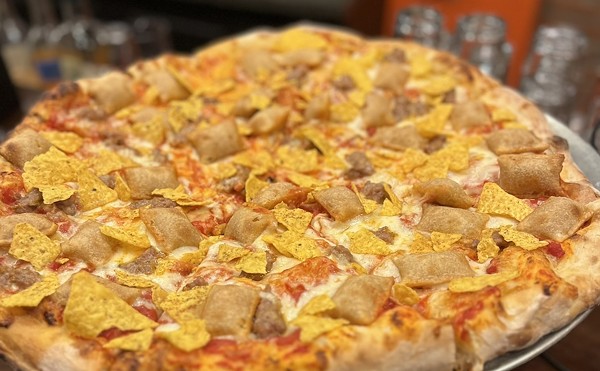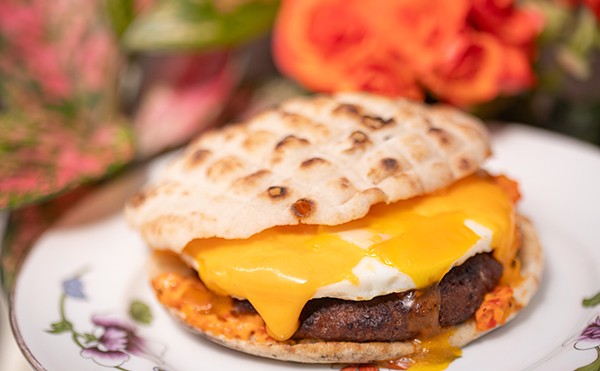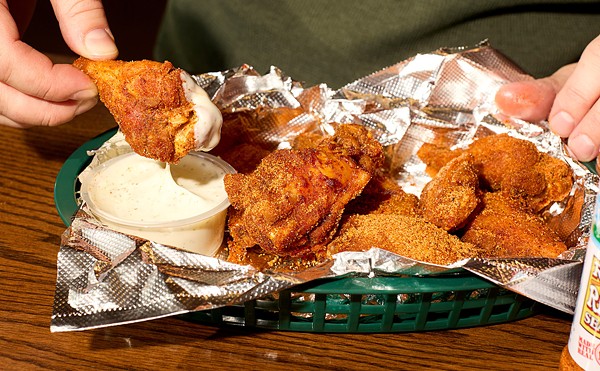Imagine our delight, then, when we opened the menu at Bella Città to find chargrilled monkfish, marinated Syrian duck breast and coffee-crusted pork medallions. Even the restaurant's chicken breast, the drowsiest dish on any menu, is roasted with pan drippings and tarted up with pears, pine nuts, raisins and garlic. Chef Paul Hayes plans to use traditional recipes from 17 Mediterranean countries, with about half that many cuisines represented on each seasonal menu. He intends to vary the dishes quarterly, whereas most Hill menus seem as permanently etched as tombstones.
Bella Città's Arab-influenced first menu delivers on its heady promises. The ingredients -- lamb medallions, certified Angus beef, pomegranates, preserved lemons -- are top-drawer. (The store-bought ice cream and house bread are among the few inferior-quality products that reach the table.) Hayes purchases some produce, such as kohlrabi and baby golden beets, from local organic growers. He makes his own veal, lobster, pheasant and other stocks. In fact, Hayes interned with a master saucier when he completed culinary school and has developed a clever specialty of using sauces fortified with wine and spirits.
Chef Hayes deglazes, infuses, emulsifies and reduces his way to an entrancing alchemy. Take his appetizer of New Zealand mussels: They're sautéed with Roma tomatoes and leeks in a contemporary velouté of lobster stock, herbs, saffron and a splash of anisette. It's the kind of sauce you can't resist slurping from a spoon when the shellfish are gone. Ravioli nudi, which has quickly become the restaurant's signature appetizer, begins with an herb-and-monkfish mousse piped onto squares of dough. Ample morsels of shrimp and scallop are tucked into the frothy filling before each piece is sealed. The dish is finished with a filmy sauce of lobster stock, sherry and puréed strained tomatoes.
Instead of making his sauces ahead of time, Hayes whips up each one when an order comes in, allowing him to omit garlic, peppers or any other ingredient a diner can't abide. But we recommend trusting the chef's judgment. His entrée of boneless breast of pheasant, for example, is napped in a prosciutto Marsala cream sauce with just a whiff of rosemary, an herb that's redolent of Pine-Sol when used injudiciously. Hayes's flair as a saucier is most apparent in his signature shrimp trio, which features shellfish so pumped up that they ought to be sporting tiny posing trunks. The little fellows are prepared in the style of three different Mediterranean cuisines. Moroccan shrimp, nestled on a heap of couscous, are dabbed with a currylike sauce of roasted garlic, tomatoes and a pinch of cinnamon. Sicilian shrimp, paired with handmade gnocchi, wear a light jacket of herbed breadcrumbs. Spanish shrimp, piled atop saffron rice, are blanketed with romesco rojo, a Catalonian red-pepper-and-tomato sauce.
Whether he's preparing a game bird or a vegetable, Hayes likes to recruit just enough other flavors to punctuate the main ingredient. This principle worked in all but a few of the dishes we tried. Our sea scallops, bitter specimens without a hint of sweetness, were steamrollered by a brash red pepper-lime coulis. Roulade de veau, on the other hand, had all the personality of Martha Stewart's wardrobe. The veal's layered look is created by stacking spinach, roasted red peppers and Boursin cheese on the thinly pounded meat before it's rolled up. Then the spool is sautéed, arranged on wild-mushroom risotto and draped with burgundy demiglace. The menu description sounded appealing, but the mildness of the veal combined with the mellow character of the fillings totted up to a Milquetoast dish.
Restaurants without the means to hire a pastry chef often purchase confections from local bakeries or wholesale suppliers. But Hayes prefers to stock his own pie safe. Even the sorbets are house-made. We sampled the springlike strawberry-kiwi flavor and the puckery Champagne sorbet, which is actually made with still white wine and citrus juices. Hayes sometimes serves it as an intermezzo to cleanse the palate. One evening, he offered a fleshy port-poached pear with a velvety blend of sabayon and mascarpone in its hollowed-out belly. But a couple of fruit desserts veered off course. A baked peach was as leathery as a dried apricot. Sautéed pears, prepared tableside, were imbued with Sterno vapors. The gummy vanilla ice cream plunked on top failed to mask the petrol bouquet.
Hayes and Bella Città's owner, Chris Heisler, plan to make some changes that could be dicey. First, they've decided to lower prices, because many of the entrées now cost well above $20. We'd rather shell out a few bucks more than see those Schwarzenegger shrimp shrink to the size of Hans and Franz. Second, Hayes wants to pare down his list of 23 main courses, which can leave wishy-washy diners stricken with indecisiveness. We hope he has the good sense to weed out dishes such as shrimp scampi, pasta primavera and linguini with clam sauce, which are best left to the pros at the Olive Garden. Alarmingly, Hayes says he's received numerous special requests for chicken Parmigiana and veal piccata. We worry that he'll menu these Italian-American warhorses for fear of losing the après-bocce-ball business. Finally, Heisler and Hayes intend to expand the list of dishes prepared tableside from two or three to about a dozen. If Bella Città wants to recalculate the timeworn Hill formula, why cling to this dirgelike ritual? Let the chef do the cooking in the kitchen, where it belongs.
The restaurant is housed in the space formerly occupied by Gian-Pepe's, whose gloomy décor used to make us wonder whether there were caskets stacked three deep in the walk-in. Heisler and his crew began the building's renovation by stripping the drywall to expose the original brick. In the process, they discovered a couple of old windows that had been concealed. They slathered stucco over most of the walls, leaving the brick exposed here and there to mimic a crumbling façade. Bucolic vistas painted in the windows and a panoramic mural on the back wall give customers the illusion of gazing from a waterfront Mediterranean villa. A stained-glass soffit brightens the shadowy space with a skylight effect. Admittedly, the room resembles a stage set and lacks the slick architectural buildouts of restaurants such as SqWires, Harvest and The Crossing. Nevertheless, it's clean, uncluttered and inviting, leaving the artistry on the plate.
Bella Città's middle-aged waiters swagger about the room like Donald Rumsfeld. They seem confident in their new uniforms -- tasteful vests over collarless shirts trimmed with snazzy black piping. They've earned their stripes, too. Heisler and the restaurant's head waiter both went through basic training at Tony's, the Parris Island of the St. Louis restaurant business.
We can only hope that Hayes and Heisler don't adopt a focus-group mentality, churning out pasta con broccoli and chicken flamingo to boost their poll numbers. With faith in Hayes' exceptional talent, Bella Città could gain a reputation for offering the Mediterranean equivalent of couture food. The menu might not receive high favorable ratings from the fritto misto crowd, but swing diners from around the metro area will go out of their way to see what Hayes has hatched each season. If he cooks it, they will come.





